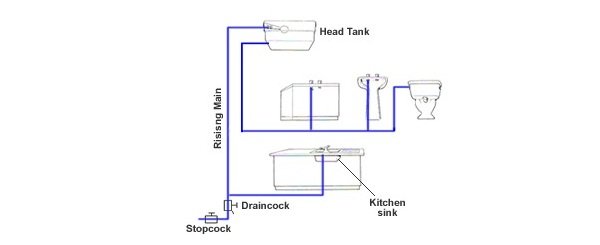Water supply system draws water from the source and makes it available for various uses in house. Water entering house can either be via direct supply or indirect supply.
In direct supply, all the household appliances (fixtures) receive water directly from the mains (i.e direct supplies from the authorities that collects water from source, treats it and distribute same. These water supply authorities may be either a municipality or city government or local authorities or private supply companies). Whereas in indirect water supply system, water is first filled into cistern (tank; overhead or underground) from mains and the appliances receive water from the cistern(tank) mostly overhead water tank.
Indirect water supply system is the most common type in modern houses, in countries like India, Pakistan, and countries in Asia and Africa and other developing countries where there is no 24 x 7 water supply by city government. Here, water enters house from the rising main (main pipe from where water enters house), which is branched off into kitchen sink and storage tank either underground or overhead. Only kitchen sink receives potable water directly from municipal mains. All the other appliances receive water from the storage tank. The storage tank is kept at height so that water comes down into fixtures through gravity at sufficient pressure.

Indirect Water Supply System
Advantages:
- Indirect water supply system, impose less pressure on distribution network, as rising main is not connected to all fixtures directly.
- There is no threat of pipe burst.
- If main is damaged or when water supply is stopped during certain time period; water can still be made available to users from the storage tanks.
- Less wear and tear of all fixtures because of less pressure and plumbing materials.
- Water leakages are less because water pressure will be less from tank and less water will escape and have less loss.
Disadvantages:
- Normally, storage water tanks are kept on roof top due to which there is not enough pressure on immediate lower floor causing problem in working of showers and flush valves in particular.
- Water stored in storage tank degraded over a period of time from quality point of view.
- Additional pipe network is required for carrying water to storage tank and from storage tank to appliances, increasing cost of pipe works and of course of pumps.
- Potable water may not be available at all taps.
- If sufficient pressure is not available, booster pumps are required for getting water at pressure. i.e 7 to 10m heat.
- You have to regularly operate and maintain pumps.
- The tank will always need maintenance and may create problem of leakages.
- The tank adds cost to the building.
- The tank also adds to the dead weight of the building.

